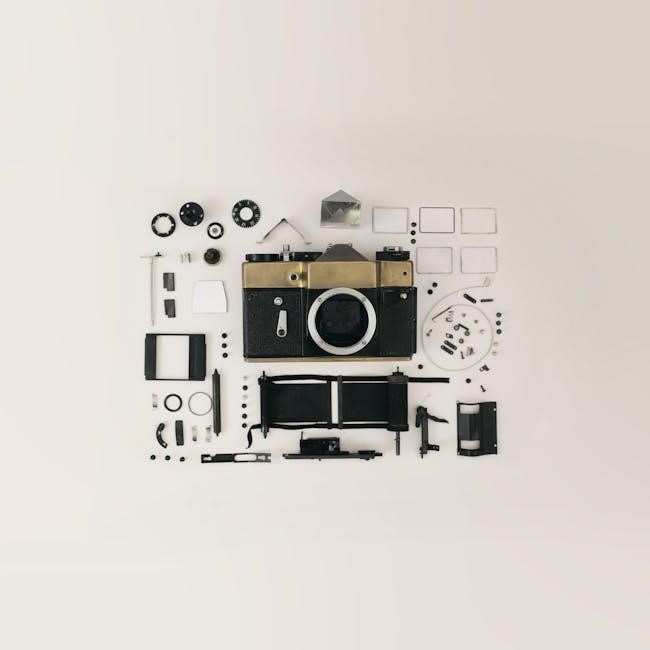Schiit Modi 3: A Comprehensive Guide
The Schiit Modi 3 is a versatile and affordable digital-to-analog converter (DAC)․ It accepts USB and SPDIF inputs, offering flexibility for various audio sources․ Like other Schiit products, the Modi 3 aims to deliver excellent performance and value, making it a popular choice among audiophiles on a budget․
The Schiit Modi 3 is a compact and versatile digital-to-analog converter (DAC) designed to enhance your audio experience․ Drawing inspiration from Norse mythology, where Modi is one of Thor’s sons, this DAC aims to be a reliable and powerful component in your audio setup․ It serves as an all-in-one USB and SPDIF DAC, offering a convenient way to improve the sound quality from various digital sources․
The Modi 3 can be used as the sole DAC for a stereo system, offering digital inputs for USB, coaxial, and optical sources․ It then outputs analog audio through RCA jacks․ Many users find that the Modi 3 offers all the DAC functionality they need at an accessible price point․
Whether you’re connecting it to your computer via USB or using it with a coaxial or optical source, the Modi 3 is designed for easy setup and operation․ This guide aims to provide you with a comprehensive overview of the Schiit Modi 3, covering its features, connections, setup, troubleshooting, and more, ensuring you get the most out of this capable DAC․
Modi 3 Features and Specifications
The Schiit Modi 3 is designed with a focus on delivering high-quality audio in a compact form factor․ It supports multiple digital inputs, including USB, coaxial, and optical (SPDIF), offering compatibility with a wide range of devices such as computers, streamers, and CD players․ The DAC utilizes a high-performance digital-to-analog conversion chip to ensure accurate and detailed sound reproduction․
Key features of the Modi 3 include its ability to be powered via USB, simplifying connectivity and reducing cable clutter․ It also boasts RCA analog outputs for easy connection to amplifiers, preamps, or receivers․ The device is designed to meet Class B digital device limits under Part 15 of the FCC Rules, ensuring it operates within acceptable electromagnetic interference levels․

The Modi 3 supports high-resolution audio formats, providing a noticeable improvement over standard audio sources․ Its compact size makes it ideal for desktop setups or smaller audio systems where space is limited․ With its combination of versatile inputs, quality components, and user-friendly design, the Modi 3 is a compelling option for audio enthusiasts seeking an affordable and effective DAC solution․
Connections: Inputs and Outputs

The Schiit Modi 3 offers a versatile set of connections to accommodate various audio setups․ On the input side, it features a USB Micro connection, allowing you to connect it to your computer for use as a USB DAC․ Additionally, it includes both optical (Toslink) and coaxial (SPDIF) digital inputs, providing compatibility with CD players, streamers, and other digital audio sources․
For outputs, the Modi 3 is equipped with standard RCA analog outputs․ These outputs allow you to connect the Modi 3 to your amplifier, preamp, or receiver, sending the converted analog audio signal for amplification and playback․ The RCA outputs are designed to deliver a clean and clear audio signal, ensuring high-quality sound reproduction․
When using the Modi 3 as a USB DAC, the USB connection can also provide power to the device, simplifying the setup․ However, an optional 5V USB wall-wart can be used for power if needed․ The variety of input options and the standard RCA outputs make the Modi 3 a flexible and easy-to-integrate component in any audio system, providing a convenient way to enhance your audio experience․
Setting Up Your Modi 3
Setting up your Schiit Modi 3 is a straightforward process that can be completed in a few simple steps․ First, decide which input you will be using: USB, optical, or coaxial․ If you’re using USB, connect the Modi 3 to your computer using the provided USB Micro cable․ For optical or coaxial inputs, connect your digital audio source to the corresponding input on the Modi 3 using appropriate cables․
Next, connect the RCA analog outputs on the back of the Modi 3 to your amplifier, preamp, or receiver․ Ensure that you are using high-quality RCA cables to maintain optimal audio quality․ If you’re using the Modi 3 as a USB-only DAC, the USB connection should provide sufficient power․ However, if you experience any power-related issues or are using optical or coaxial inputs, you may need to connect the optional 5V USB wall-wart for power․
Once all connections are made, select the correct input on your amplifier or receiver to correspond with the Modi 3’s output․ Finally, power on your Modi 3 (if using the wall-wart) and begin playing audio from your chosen source․ You may need to install drivers on your computer for USB audio playback, depending on your operating system․ With these steps completed, your Modi 3 should be set up and ready to deliver high-quality audio․
Using Modi 3 as a USB DAC

Utilizing the Schiit Modi 3 as a USB DAC is a common and effective way to enhance your computer audio․ To begin, connect the Modi 3 to your computer using the provided USB Micro cable․ This single connection serves both to transmit audio data and, in most cases, to power the device․ Ensure the USB cable is securely connected to both the Modi 3 and a USB port on your computer․
Next, you might need to configure your computer’s audio settings to recognize and utilize the Modi 3․ In your operating system’s sound control panel, select the Modi 3 as the default playback device․ This directs all audio output from your computer through the Modi 3․ Depending on your operating system (Windows or macOS), drivers might be automatically installed, or you may need to manually install them․

Once the Modi 3 is selected as the default audio device, you can begin playing audio from any application on your computer․ The Modi 3 will receive the digital audio signal via USB, convert it to analog, and output it through the RCA jacks on the rear of the device․ Connect these RCA outputs to your amplifier or powered speakers for an improved listening experience․ Remember to adjust the volume levels on both your computer and amplifier to achieve your desired sound level․
Using Modi 3 with SPDIF (Optical/Coaxial)
Besides USB, the Schiit Modi 3 offers SPDIF connectivity via optical (Toslink) and coaxial inputs, expanding its compatibility with various audio sources like CD players, streamers, and game consoles․ To use the Modi 3 with SPDIF, first, select the appropriate digital input using the input selector switch located on the rear panel․ Ensure the switch is set to either optical or coaxial, depending on your source’s output․
For optical connections, use a Toslink cable to connect the optical output of your source to the Modi 3’s optical input․ Similarly, for coaxial connections, use a coaxial cable to connect the coaxial output of your source to the Modi 3’s coaxial input․ Securely connect the cables to ensure a stable digital signal transmission․
Unlike USB, SPDIF connections require a separate power source for the Modi 3․ Connect the provided 5V USB wall-wart power adapter to the Modi 3’s power input․ Once powered, the Modi 3 will receive the digital audio signal through the selected SPDIF input, convert it to analog, and output it through the RCA jacks․ Connect the RCA outputs to your amplifier or powered speakers, and adjust the volume levels on your amplifier to enjoy your audio․ Ensure your source device is set to output audio via SPDIF․

Troubleshooting Common Issues
Even with a well-designed device like the Schiit Modi 3, occasional issues can arise․ If you encounter problems, here are some troubleshooting steps to consider․ First, ensure the Modi 3 is properly connected to both your audio source and your amplifier or powered speakers․ Double-check all cable connections, including USB, optical, coaxial, and RCA, to ensure they are securely plugged in․

If you’re using USB, verify that your computer recognizes the Modi 3 as an audio device․ Check your operating system’s sound settings to ensure the Modi 3 is selected as the default output device․ If necessary, reinstall the USB drivers for the Modi 3, which can be found on the Schiit website․
For SPDIF connections, ensure the correct input is selected on the Modi 3․ Confirm that your source device is outputting audio via optical or coaxial, and that the cable is not damaged․ If you experience distorted or no audio, try a different USB cable, optical cable, or coaxial cable to rule out faulty cables․ Also, make sure that the Modi 3 is receiving adequate power from the USB power adapter․
Power Supply and Requirements
The Schiit Modi 3 is designed for efficient power consumption, making it versatile in various setups․ It primarily draws power via its USB connection when connected to a computer or other USB-equipped device․ In many cases, this USB power is sufficient for the Modi 3 to function correctly, eliminating the need for an external power supply․
However, if you experience issues like insufficient power or instability, particularly when using the Modi 3 with certain devices or at higher volumes, an external 5V USB power adapter can be used․ Schiit typically includes a USB wall-wart power adapter with the Modi 3․ Ensure the adapter meets the 5V specification to avoid damaging the device․

Using a high-quality power supply is recommended to minimize noise and ensure optimal performance․ Avoid using cheap or unreliable USB power adapters, as they may introduce unwanted artifacts into the audio signal․ When connecting the Modi 3 to a USB hub, make sure the hub provides sufficient power to all connected devices․ If issues persist, try connecting the Modi 3 directly to a USB port on your computer or using a powered USB hub․
Modi 3E: What’s New?
The Modi 3E represents an evolution of the popular Modi 3 DAC, incorporating several enhancements for improved performance and usability․ One key upgrade is the use of a more advanced USB receiver, resulting in lower jitter and better overall sound quality․ This refined USB implementation allows for cleaner signal transmission and reduced distortion, contributing to a more accurate and detailed audio reproduction․
In addition to the USB improvements, the Modi 3E often features updated analog output stages․ These enhancements typically involve the use of higher-quality components and refined circuit designs to further reduce noise and distortion․ The result is a cleaner, more transparent sound signature with improved dynamic range and clarity․

The “E” in Modi 3E often signifies “Enhanced,” reflecting these incremental but significant improvements․ While the core functionality remains similar to the Modi 3, the 3E version offers a noticeable step up in audio fidelity, making it a worthwhile upgrade for discerning listeners seeking the best possible sound from a compact and affordable DAC․

Where to Find the Owner’s Manual
Locating the owner’s manual for your Schiit Modi 3 or Modi 3E is typically straightforward․ The primary source for the manual is the official Schiit Audio website․ Navigate to the “Support” or “Downloads” section of their site, and search for the Modi 3 or Modi 3E product page․
On the product page, you should find a downloadable PDF version of the owner’s manual․ This manual contains detailed information about the DAC’s features, specifications, setup instructions, and troubleshooting tips․ It’s a valuable resource for understanding how to properly use and maintain your Modi 3․
In addition to the official website, you may also find the owner’s manual on various online forums, audio review sites, or document sharing platforms․ However, it’s always recommended to download the manual directly from the Schiit Audio website to ensure you have the most accurate and up-to-date version; The manual provides essential guidance for optimizing your listening experience and resolving any potential issues․
